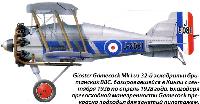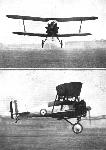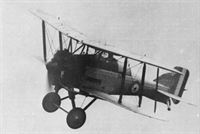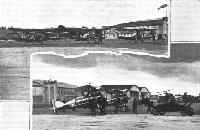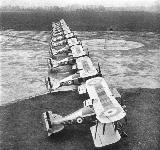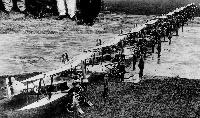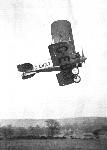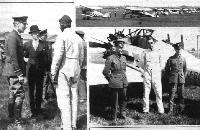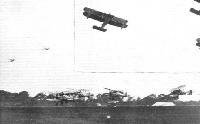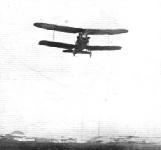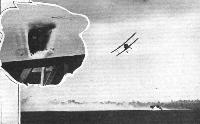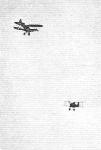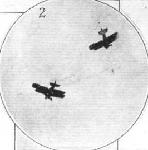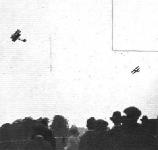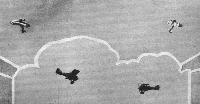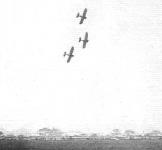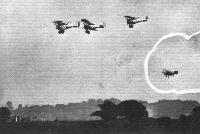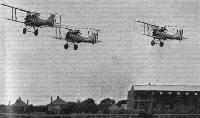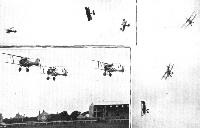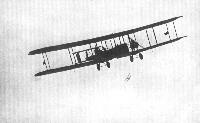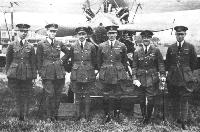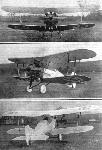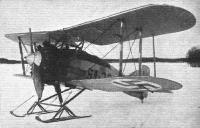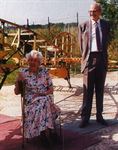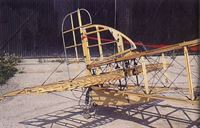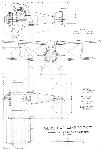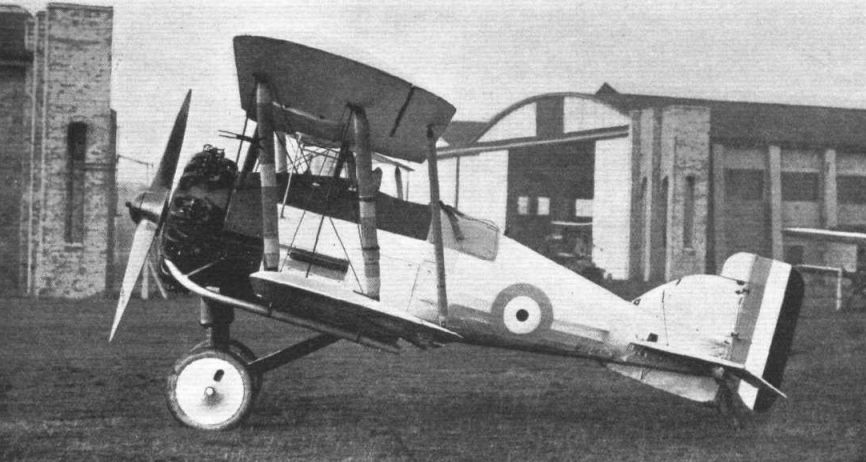
Варианты
Gloster Gamecock
Самолет Gamecock, построенный по техническому заданию 27/23 Министерства авиации на одноместный истребитель, был еще одним представителем удачного семейства машин Grouse/Grebe. От предшественников он отличался, прежде всего, двигателем Bristol Jupiter, заменившим Armstrong Siddeley Jaguar, надежность которого оставляла желать лучшего. Другие отличия включали усовершенствованные элероны, измененные обводы фюзеляжа и внутреннюю установку двух пулеметов. Впервые взлетевший в феврале 1925 года, Gamecock быстро прошел испытания, по результатам которых изменили конструкцию оперения.
Доработанный таким образом первый из трех прототипов показал хорошие результаты, достаточные для получения контракта на 30 серийных истребителей Gamecock Mk I. Первый из них поступил на вооружение 23-й эскадрильи в мае 1926 года и нес службу до июля 1931 года. В общей сложности британские ВВС приобрели около 100 Gamecock, включая три Gamecock Mk II с новой центральной секцией верхнего крыла и рядом более мелких усовершенствований. Помимо британских ВВС "Gloster" поставила три Gamecock Mk II Финляндии, где еще 15 самолетов были построены по лицензии в 1929-1930 годах. Получившие название Kukko, эти самолеты несли службу в боевых частях финских ВВС с 1929 по 1935 годы, а затем использовались в качестве учебных. Последний из них был списан в 1941 году.
Вариант
Gamecock Mk III: Gamecock Mk II, принадлежавший британским ВВС, прошедший доработки и использовавшийся для испытаний на штопор
ТАКТИКО-ТЕХНИЧЕСКИЕ ХАРАКТЕРИСТИКИ
Gloster Gamecock Mk I
Тип: одноместный истребитель
Силовая установка: один радиальный двигатель Bristol Jupiter VI мощностью 425 л. с. (317 кВт)
Летные характеристики: максимальная скорость на высоте 1525 м - 249 км/ч; время набора высоты 3050м - 7 мин 35 с; потолок 6705 м; продолжительность полета 2 ч
Масса: пустого 875 кг; максимальная взлетная 1299 кг
Размеры: размах крыла 9,08 м; длина 5,99 м; высота 2,95 м; площадь крыла 24,53 м1
Вооружение: два 7,7-мм пулемета Vickers Mk I по бортам носовой части фюзеляжа
Описание:
- Gloster Gamecock
- Flight, April 1926
THE GLOSTER "GAMECOCK” - Flight, June 1927
GLOSTER "GAMECOCKS" FOR FINLAND - Flight, July 1928
GLOSTER "GAMECOCK II”
Фотографии
-
Air Enthusiast 1971-09 / R.Braybrook - Biplane Era: The Flight from Reality /Fighters in the RAF/ (1)
Регистрационный номер: J7914 [2] Gloster Gamecock I of No 23 Squadron (1929).
-
Мировая Авиация 140
Регистрационный номер: J8081 [2] Gloster Gamecock Mk I из 32-й эскадрильи британских ВВС, базировавшейся в Кинли с сентября 1926 по апрель 1928 года. Благодаря превосходной маневренности Gamecock прекрасно подходил для занятий пилотажем.
-
Aeroplane Monthly 1991-06 / A.Lumsden - On silver wings (9)
Classic Flight photograph of Fg Off Howard Saint DSC, Gloster’s chief test pilot, demonstrating Gloster Gamecock II J7910 in February 1928.
-
Flight 1928-09 / Flight
FORE! Two views secured some little time ago of the "Gloster Gamecock II" with Bristol "Jupiter" engine at full speed. Our photographer is still with us.
-
Aeroplane Monthly 1991-06 / A.Lumsden - On silver wings (9)
The Gloster Gamecock II prototype, powered by one 425 h.p. Bristol Jupiter VII, being demonstrated for Flight’s photographer in 1927.
Howard Saint takes another swipe at Flight’s photographer while flying Gamecock II J7497 in February 1928. -
Aeroplane Monthly 1991-07 / O.Thetford - On sliver wings (10)
Регистрационный номер: J7910 [7] Classic Flight photograph of Fg Off Howard Saint DSC, Gloster’s chief test pilot, demonstrating Gloster Gamecock II J7910 in February 1928.
-
Flight 1928-09 / Flight
Регистрационный номер: J7910 [7] THE "GLOSTER GAMECOCK II," Bristol "Jupiter" engine, in various attitudes of flight. The pilot on this occasion, some little time ago, was Flying Officer Howard J. T. Saint, D.S.C., chief test pilot to the Gloster Aircraft Company. He is seen in the inset.
-
Aeroplane Monthly 1974-01 / Gloster Gamecock II /Press Debut/
Регистрационный номер: J7910 [7] -
Aeroplane Monthly 1991-06 / A.Lumsden - On silver wings (9)
Регистрационный номер: J7497 [3] IN THE "FLY PAST" at the R.A.F. DISPLAY: The Gloucestershire "Gamecock" single-seater Fighter (400 h.p. Bristol "Jupiter").
The first prototype Gamecock, J7497, after installation of horn-balanced rudder. -
Aeroplane Monthly 1991-06 / A.Lumsden - On silver wings (9)
Регистрационный номер: J7497 [3] Another view of the first Gamecock. It was powered by a Jupiter IV engine.
-
Aeroplane Monthly 1991-06 / A.Lumsden - On silver wings (9)
Регистрационный номер: J7497 [3] Gamecock prototype (J7497) had faired Jupiter IV and S.E.5a/Grebe-type fin and rudder.
-
Aeroplane Monthly 1991-06 / A.Lumsden - On silver wings (9)
Регистрационный номер: J7757 J7757 was the third prototype Gamecock and was powered by a 425 h.p. Jupiter VI. It was last flown in December 1927.
-
Flight 1926-07 / Flight
Регистрационный номер: J7808 The Gloster "Gamecock" (Bristol "Jupiter") Although not unlike the Gloster "Grebe" in general appearance, the "Gamecock" incorporates a number of special features, improvements, etc., to which, however, no reference may be made here. Apart from the fact that a Bristol "Jupiter" of the latest type, similar to that which flew 25,000 miles between Croydon and Bristol, is fitted, the "Gamecock" is remarkable for the convenient manner in which its various pieces of equipment are arranged so as to be easily accessible, a feature of the very greatest importance in service work. At present the only squadron equipped with "Gamecocks" is No. 23 (Fighter) squadron, Henlow.
-
Aeroplane Monthly 1991-07 / O.Thetford - On sliver wings (10)
Регистрационный номер: J7894, J7903 Hooton Air Pageant: Three Gloucester ''Gamecocks" of No.23 (Fighter) Squadron flying past the enclosures in very close formation. They gave a thrilling show of air fighting and aerobatics.
A formation of three 23 Sqn Gamecocks led by J7903 with J7894 nearest the camera. J7903 was lost on November 7, 1929 when it collided with J8409 near Wallington, Surrey. -
Aeroplane Monthly 1991-07 / O.Thetford - On sliver wings (10)
Регистрационный номер: J7908 [4], J8090 [2], J8415 R.A.F. ITEM: Three R.A.F. Gloster "Gamecocks" flying low in formation. These machines played a prominent part in the Pageant.
Gamecocks J7908, J8090 and J8415 taking part in the Hampshire Air Pageant held at Hamble on May 31, 1928. J8415 collided with Gamecock J8094 over RAF Kenley on March 1 the following year. -
Aeroplane Monthly 1991-06 / A.Lumsden - On silver wings (9)
Регистрационный номер: J7908 [4] Maurice Piercey demonstrating Gamecock J7908 at Brockworth in March 1926. This aircraft was later delivered to 43 Sqn, based at RAF Tangmere from April 1926 until June 1928.
-
Flight 1926-04 / Flight
Регистрационный номер: J7908 [4] AT BROCKWORTH AERODROME: These three photographs of the "Gloster Gamecock" with Bristol "Jupiter" engine show the machine during a test flight, piloted by Maurice Piercey.
-
Aeroplane Monthly 1991-07 / O.Thetford - On sliver wings (10)
Регистрационный номер: J7908 [4] 43 Sqn Gamecock I J7908. Based at RAF Tangmere, this Gamecock remained with the squadron from April 1926 until June 1928.
-
Aeroplane Monthly 1991-06 / A.Lumsden - On silver wings (9)
Регистрационный номер: J7910 [7] Gamecock J7910 was used for dive and anti-flutter trials by the A&AEE during 1927 and was later converted to Mk II standard. It was powered by a 425 h.p. Jupiter VI radial.
The “WT” markings on this Gloster Gamecock showed that the AID had verified the electrical bonding of metal parts - this took the form of wire connections to prevent the build-up or sudden discharge of static electricity and the consequent risks of radio interference or fire. -
Aeroplane Monthly 1998-12 / M.Brett - A brace of Gamecock? /Replica project/
Регистрационный номер: J7910 [7] Another view of Gamecock J7910, taken just before installation of the anti-flutter struts.
-
Aeroplane Monthly 1998-12 / M.Brett - A brace of Gamecock? /Replica project/
Регистрационный номер: J7910 [7] The shape of things to come. Gamecock J7910 displays its jaunty lines at the Aeroplane and Armament Experimental Establishment at Martlesham Heath in the summer of 1927. This photograph was taken after the installation of auxiliary vee struts outboard of the interplane struts to combat wing flutter - a phenomenon which will have to be watched for in any flying replica.
-
Aeroplane Monthly 1991-07 / O.Thetford - On sliver wings (10)
Регистрационный номер: J7914 [2], J8406 Two 23 Sqn Gamecock Is possibly photographed at RAF Kenley. Nearer the camera is J7914, destroyed when it stalled off a steep turn after taking off from Sutton Bank, Lincs on August 14,1929. Behind is J8406.
-
Aeroplane Monthly 1982-07 / P.Capon - Capon's Corner
Регистрационный номер: J7919 The No 43 Sqn Gloster Gamecock I J7919, resplendent in black and white check squadron markings, seen at Stag Lane in September 1926, the same year that the type entered RAF service. Apart from No 43 Sqn, based then at Tangmere, the RAF equipped four other squadrons with Gamecocks and took delivery of a total of 82 of these pretty fighters. Mk I and II Gamecocks were powered by the 425 h.p. Bristol Jupiter VII nine-cylinder engine.
-
Aeroplane Monthly 1991-07 / O.Thetford - On sliver wings (10)
Регистрационный номер: J8037 43 Sqn Gamecock I J8037. Pennants were often carried by aircraft flown by squadron commanders.
-
Aeroplane Monthly 1974-05 / D.James - A country Gamecock
Регистрационный номер: J8047 [2] Bill Tomkins' Gamecock before civil conversion. It is being flown by Capt Howard Saint at Hucclecote in August 1928, and has enlarged fin and rudder, lengthened fuselage, additional centre section strutting and parallel chord ailerons. The armament has been retained, and is visible in the fuselage side troughs.
-
Aeroplane Monthly 1991-07 / O.Thetford - On sliver wings (10)
Регистрационный номер: J8073 Gamecock I J8073 of 32 Sqn, RAF Kenley, flown by Fg Off A. H. Montgomery in the Sir Philip Sassoon Cup at RAF Northolt on May 26, 1927.
-
Aeroplane Monthly 1991-07 / O.Thetford - On sliver wings (10)
Регистрационный номер: J8082 [2] A delightful photograph of 23 Sqn Gamecock Is. J8082 has just been started with the help of a Hucks starter, which is about to attend to the second aircraft.
-
Flight 1928-08 / Flight
Регистрационный номер: J8082 [2] THE AIR DEFENCE EXERCISES: With No. 23 (Fighter) Squadron, Kenley. The top picture shows a few of the squadron's "Gamecocks" off duty for a few hours, while below is seen a scene immediately after an alarm was received. The Hucks starter got busy without delay.
-
Flight 1930-11 / Flight
Регистрационный номер: J8040 [3], J8084 [3] The full complement of 12 Gloster Gamecocks (Jupiter engines) of No. 23 (Fighter) Squadron at Kenley.
-
Aeroplane Monthly 1998-09 / R.Nesbit - RAF reflections
Регистрационный номер: J8040 [3], J8084 [3] No 23 Sqn at Kenley was the second unit to replace its Gloster Grebes with Gamecocks, and kept the latter long after other squadrons had re-equipped; 23’s Gamecocks, shown here in 1927, were finally replaced in July 1931 by Bristol Bulldogs.
-
Мировая Авиация 66
Регистрационный номер: J8040 [3], J8084 [3] Первым местом службы Бадера стала 23-я истребительная эскадрилья в Кенли, вооруженная бипланами Gloster Gamecock. Бадер проявил исключительное летное мастерство и был выбран для участия в демонстрационных полетах на авиационной выставке в Хендоне в 1931 году. На глазах у 170 000 зрителей Бадер продемонстрировал головокружительный высший пилотаж.
-
Aeroplane Monthly 1991-07 / O.Thetford - On sliver wings (10)
Регистрационный номер: J8041, J8083, J8408 A line-up of four 23 Sqn Gamecock Is. Nearest the camera are J8408, J8041 and J8083. The squadron’s eagle badge (an eagle preying on a falcon) may be seen on the fin of J8408.
-
Aeroplane Monthly 1991-07 / O.Thetford - On sliver wings (10)
Регистрационный номер: J8409 "SISKIN" v. "GAMECOCK": The two types represented in the Sassoon Cup: The Gloster "Gamecock" (Bristol "Jupiter") piloted by Sergt. Freeman (Kenley)
Classic Flight photograph of Gamecock I J8409, showing well the 23 Sqn fuselage markings. Sgt Freeman from RAF Kenley takes off from RAF Northolt on May 28, 1929 at the start of the Sassoon Cup race. He came fourth. -
Aeroplane Monthly 1991-07 / O.Thetford - On sliver wings (10)
Регистрационный номер: J8421 Although heavily retouched, this view of Gamecock I J8421 shows well the wing markings of 43 Sqn. After less than a month with this unit, J8421 passed to 23 Sqn.
-
Aeroplane Monthly 1991-06 / A.Lumsden - On silver wings (9)
Регистрационный номер: G-EBNT [3] A standard Gamecock I was given the civil registration G-EBNT, registered to the Gloucestershire Aircraft Company and used as a demonstrator during 1926.
-
Flight 1926-04 / Flight
Регистрационный номер: G-EBNT [3] WELL AWAY: This photograph of the civilian version of the "Gloster Gamecock" gives an excellent idea of the general lines. The engine is a Bristol "Jupiter."
-
Flight 1926-04 / Flight
Регистрационный номер: G-EBNT [3] Manoeuvrability is a feature of the "Gloster Gamecock" as well as its civilian version, the latter being shown in above photographs. The view of the machine in a steeply-banked turn gives a plan view, while in the inset the machine is seen in front elevation, which admirably illustrates the clean design.
-
Aeroplane Monthly 1974-05 / D.James - A country Gamecock
Регистрационный номер: G-ADIN [4] Bill Tomkins taxies G-ADIN prior to its first flight after rebuilding. Note that a spinner has been fitted.
-
Aeroplane Monthly 1974-05 / D.James - A country Gamecock
Регистрационный номер: G-ADIN [4] G-ADIN at Sywell, showing the uncowled crankcase and cylinders of the Jupiter engine.
-
Aeroplane Monthly 1974-05 / D.James - A country Gamecock
Регистрационный номер: G-ADIN [4] Bill Tomkins, watched by a farm dog, straps on a parachute in preparation for flight.
-
Air Pictorial 1957-06 / R.Cross - The Gloster Gamecock I
R.A.F. Gamecock I of No.23 Squadron is shown with standard tail and extra centre-section and wing-tip bracing struts.
-
Air Enthusiast 1971-09 / R.Braybrook - Biplane Era: The Flight from Reality /Fighters in the RAF/ (1)
Gloster’s successor for the Grebe, evolved to an official specification in the mid-twenties, was the Gamecock, illustrated here in the markings of No 56 Squadron (No 43 Sqdn. ???). Only seven squadrons were equipped with Gamecocks.
-
Flight 1926-04 / Flight
A VERY NEAT ENGINE INSTALLATION: In the civilian version of the "Gloster Gamecock" no exhaust pipes are fitted, as the machine is not intended for night flying, and a cowl of very pleasing appearance is fitted. The "spinner" is in the form of a swelling of the propeller boss, and is built integral with it, only the small pointed nose-cap being a separate metal fitment. The undercarriage is of special oleo-damped type.
-
Flight 1927-06 / Flight
TWO BROTHERS: On the left the "Gloster Gamecock," with Bristol "Jupiter" engine, as supplied to the British Royal Air Force. On the right the civilian version, which will be used for demonstration purposes abroad. The absence of "whiskers," in the form of exhaust pipes, on the civilian "brother" results in a much cleaner appearance.
-
Flight 1928-06 / Flight
THE SERVICE SHARE OF THE MIDLAND PAGEANT: The Gloster "Gamecocks" (Bristol "Jupiter") from No. 43 (Fighter) Squadron, Tangmere, played a prominent part in the Pageant Programme. Our picture shows the machines parked.
-
Flight 1927-05 / Flight
THE HAMPSHIRE AIR PAGEANT: A few of the many machines that took part in the programme.
-
Flight 1929-05 / Flight
THE SASSOON CUP. The line-up of Siskins and Gamecocks representing 12 Fighter Squadrons.
Другие самолёты на фотографии: Armstrong Whitworth Siskin - Великобритания - 1921
-
Flight 1927-06 / Flight
On the left, Air Marshal Sir John M. Salmond, Air Officer Commanding-n-Chief, Air Defences of Great Britain, and Sir Philip Sassoon, Under-Secretary of State for Air, congratulating Pilot-Officer Montgomery on his victory in the race for the Sassoon Cup. On the right, P/O Montgomery and his fitter and rigger, Leading Aircraftsmen Jenkins and Price. Inset, the machines lined up for the start.
-
Flight 1929-05 / Flight
WINNING PILOTS AND MACHINES OF R.A.F. FIGHTER COMPETITION: (Right to Left) F/O C. H. Jones and F/O H. A. Purvis of No. 23 (Fighter) Squadron who won on the Gloster "Gamecocks" (Jupiters) seen in flight and stationary.
-
Aeroplane Monthly 1998-12 / D.Webb - The unsung gallants /Test flyers/ (2)
The Home Defence aerobatic champions of 1929 in front of a 23 Sqn Gloster Gamecock. Left, Fg Off C.H. Jones; right, Fg Off H. A. “Bruin” Purvis, who as a group captain became OC Flying at A&AEE Boscombe Down during the war.
-
Aeroplane Monthly 1988-09 / P.Cooksley - RAF Kenley. Bulwark of London (1)
Douglas Bader, right, in front of a 23 Sqn Gloster Gamecock on a rainy day in 1927. Note the white shirts worn by officers of the period.
-
Aeroplane Monthly 1982-11 / D.Middleton - Douglas Bader
Douglas Bader took part in the 1931 RAF Pageant at Hendon where, as a Pilot Officer with No 23 Sqn, he flew synchronised aerobatics in a Gloster Gamecock with Flt Lt H. M. Day. The pair are seen taxiing in, or out, at Hendon in July during their performance. Flight commented: "Altogether the demonstration was very pretty, and the two pilots showed great skill and judgement of speed and distance."
-
Flight 1927-06 / Flight
THE SIR PHILIP SASSOON CUP RACE AT NORTHOLT: Three Gloster "Gamecocks" are here shown starting for the race.
-
Flight 1927-05 / Flight
THE HAMPSHIRE AIR PAGEANT: Event 3, Flying boat v. Land 'plane. Three Supermarine "Southampton" flew over the aerodrome, at which a formation of 5 Gloster "Gamecocks" ascended and chased them away.
-
Flight 1927-07 / Flight
THE MORNING'S PROGRAMME: 4, Start of the altitude race between "Gamecocks" and "Siskins."
Другие самолёты на фотографии: Armstrong Whitworth Siskin - Великобритания - 1921
-
Flight 1929-01 / Flight
MORE BRITISH AIRCRAFT FOR FINLAND: A Gloster "Gamecock" with "Jupiter" engine, one of a batch being built for the Finnish Air Force, being tested by Mr. Saint at the Gloster aerodrome at Brockworth.
-
Flight 1928-07 / Flight
STUNTING AT HENDON: The Gloster "Gamecock" resisting gravity over the aerodrome with the help of Flight-Lieut. Horniman.
-
Aeroplane Monthly 1974-05 / D.James - A country Gamecock
Bill Tomkins flying over a ploughing team on his farm at Apethorpe in January 1936.
-
Aeroplane Monthly 1974-05 / D.James - A country Gamecock
"- TO PLOUGH AND SOW, TO LOOP AND ROLL -." Mr. J. W. Tomkins, a farmer of Apethorpe, Peterborough, Northants, is an aerobatics enthusiast and has bought himself an old Gloster Gamecock fighter and, from the R.A.F., a radial - which looks like an early Mercury or late Jupiter - for ?7. The whole outfit cost him ?25. Sword into ploughshare indeed!
The Gamecock matches its horsepower against that of the ploughing team. -
Flight 1927-05 / Flight
SEEN AT THE HAMPSHIRE AIR PAGEANT: One of Service Events; Flight-Lieut. H. C. Calvey gives a demonstration of Eccentric flying;
-
Flight 1927-06 / Flight
WINNER OF THE SIR PHILIP SASSOON CUP: The photo shows Pilot-Officer A. H. Montgomery, of 32 Squadron, Kenley, crossing the finishing line in a Gloster "Gamecock" with Bristol "Jupiter" engine as winner of the race.
-
Flight 1930-08 / Flight
A Flight of No. 23 Fighter Squadron catches the Sidestrands of No. 101 B.S. at Andover.
Другие самолёты на фотографии: Boulton Paul Sidestrand / P.29 - Великобритания - 1926
-
Flight 1928-06 / Flight
REALISTIC BOMBING AT BIRMINGHAM: One of the R.A.F. Gloster "Gamecocks" bombing the hostile "tank" - a direct hit; Insert, an indirect hit - but not on the tank. This is a hole made by the nose cap of one of the bombs in the fuselage of the Imperial Airways Handley Page, which was busy taking up "joy-riders" during the Pageant.
-
Flight 1930-07 / Flight
Individual Aerobatics: Two Gamecocks from No. 23 (Fighter) Squadron gave a fine display.
-
Flight 1927-07 / Flight
THE MORNING'S PROGRAMME: 2, Duel between two Gloster "Gamecocks" from No. 23 (Fighter) squadron. The machines were piloted by F/O. F. F. Wilkinson and F O. H. C. G. Dauncey respectively.
-
Flight 1927-07 / Flight
THE MARCHIONESS OF TOWNSHEND'S AERIAL FETE: The mimic battle between the Gloucester "Gamecock" and the Vickers "Venture."
Другие самолёты на фотографии: Vickers Vixen / Venture / Valparaiso / Valiant - Великобритания - 1923
-
Flight 1929-07 / Flight
EVENT 2. INDIVIDUAL AEROBATICS: This was given by F./O's. C. H. Jones and H. A. Purvis (No. 23 Fighter Sq.) on Gloster-Jupiter Gamecocks. After diving towards each other (as shown below), they zoomed upwards and simultaneously executed the same evolution (as shown above).
-
Flight 1926-07 / Flight
THE "SET PIECE" AT THE R.A.F. DISPLAY: An attack by fighters and day bomber on a hostile aerodrome. The views show No. 43 Squadron (Gamecocks) attacking, at low altitude, with machine gun fire and light bombs.
-
Flight 1927-05 / Flight
SEEN AT THE HAMPSHIRE AIR PAGEANT: One of Service Events; Flight-Lieut. C. R. Smythe. F. O. C. W. Byas, and Sergt.-Pilot E. H. Wells, give some fine Stunting in Formation on Gloster "Gamecocks."
-
Flight 1928-06 / Flight
THE SERVICE SHARE OF THE MIDLAND PAGEANT: The Gloster "Gamecocks" (Bristol "Jupiter") from No. 43 (Fighter) Squadron, Tangmere, played a prominent part in the Pageant Programme. Our picture shows three "Gamecocks" giving a demonstration of close formation flying
-
Flight 1928-05 / Flight
HAMPSHIRE AIR PAGEANT: The four R.A.F. Gloster "Gamecocks" flying in formation during their exhibition of drill at the Pageant, flown by Sqdr.-Ldr. C. N. Lowe, Flt.-Lieut. A. C. Collier, and Flying Officers N. A. P. Pritchett and H. C. O. Hayter.
-
Flight 1930-06 / Flight
THE SERVICE SIDE: Three Gloster "Gamecocks" of No. 23 Squadron gave a fine display of Aerobatics.
-
Flight 1930-06 / Flight
THE GLOSTER "GAMECOCK": For many years this type has been in use by R.A.F. Fighter Squadrons. It is still very popular for demonstrations and practising "Aerobatics." The engine is a "Jupiter."
-
Flight 1930-01 / Flight
Many years after the first historical flying meeting at Bournemouth in 1910, this popular resort again held a meeting, two events from which are shown here. On the left, seven machines are seen flying in a race, and on the right three R.A.F. "Gamecocks" give a display.
-
Flight 1927-06 / Flight
FORMATION-FLYING EXTRAORDINARY: During the Bournemouth Whitsun Meeting a flight of Gloster "Gamecocks" with Bristol "Jupiter" engines gave some wonderful exhibitions of stunting in formation. They are here seen taking off and carrying out various evolutions.
-
Flight 1932-05 / Flight
A FORMATION OF AIRCRAFT TYPES USED FOR INSTRUCTION AT THE CENTRAL FLYING SCHOOL: From left to right, Gamecock, Atlas, Moth, III.F, Avro-Lynx, Siskin and Bulldog.
Другие самолёты на фотографии: Armstrong Whitworth Atlas / Ajax - Великобритания - 1925Armstrong Whitworth Siskin - Великобритания - 1921Avro Avro 504N - Великобритания - 1920Bristol Bulldog - Великобритания - 1927De Havilland Gipsy Moth / Moth X - Великобритания - 1928Fairey Fairey IIIF - Великобритания - 1926
-
Flight 1931-07 / Flight
A MIXED GRILL: A formation of seven different types over Wittering, viz., "Gamecock," "Atlas," "Moth," "Fairey III F," "Avro-Lynx," "Siskin," and "Bulldog."
Другие самолёты на фотографии: Armstrong Whitworth Atlas / Ajax - Великобритания - 1925Armstrong Whitworth Siskin - Великобритания - 1921Avro Avro 504N - Великобритания - 1920Bristol Bulldog - Великобритания - 1927De Havilland Gipsy Moth / Moth X - Великобритания - 1928Fairey Fairey IIIF - Великобритания - 1926
-
Flight 1928-06 / Flight
VICKERS "VIRGINIA": Night Bomber, with two Napier "Lion" Engines.
A "Virginia " stunting, while under it and in the background may be seen a "Gloster Gamecock."Другие самолёты на фотографии: Vickers Virginia - Великобритания - 1922
-
Flight 1928-06 / Flight
THE R.A.F. AT THE BIRMINGHAM PAGEANT: Pilots of No. 43 (Fighter) Squadron added considerably to the brightness of the meeting with their Gloster "Gamecocks" (Bristol "Jupiter"). From left to right are :- P./O. Leech; F./O. H. C. O. Hayter; Flight-Lieut. A. C. Collier; Wing Commander Tyssen, M.C.; Sqdn.-Ldr. C. N. Lowe, M.C., D.F.C.; and F./O. N. A. P. Pritchett.
-
Aeroplane Monthly 1974-05 / D.James - A country Gamecock
Регистрационный номер: J8047 [2] The fuselage of Gamecock J8047 as it arrived at Manor Farm in May 1934, with Bill Tomkins, centre, and two friends who helped in the reconstruction work,
-
Aeroplane Monthly 1974-05 / D.James - A country Gamecock
A happy partnership, Bill Tomkins and friend.
-
Flight 1927-06 / Flight
AT THE SIGN OF THE SWASTIKA: Three views of a Gloster "Gamecock II" with Gnome-Rhone "Jupiter" engine recently acquired by the Finnish Air Force.
-
Air International 1980-07 / Fighter A to Z
A Gamecock II in Finnish service.
-
Jane's All the World Aircraft 1980 / Encyclopedia of Aviation - Aircraft A-Z - v3
Регистрационный номер: GA-45 One of the Gloster Gamecock IIs flown by the Finnish Air Force.
-
Air Enthusiast 1996-11 / K.Stenman - Gloster Trilogy
Регистрационный номер: GA-38 [2] The sample Gamecock GA-38 fitted with locally-designed skis, at the aircraft factory in Suomenlinna on March 9, 1928. Note the short fuselage of Mk I and later Mk II wings.
-
Flight 1928-03 / Flight
Регистрационный номер: GA-38 [2] BRITISH MACHINES IN FINLAND: Finland's Gloster "Gamecock II," on skis.
-
Air Enthusiast 1996-11 / K.Stenman - Gloster Trilogy
Регистрационный номер: GA-46 GA-46 of ‘Lentosotakoulu ’ (Air Fighting School) at Kauhava in early 1943. This machine performed the last Gamecock flight in Finland on July 22, 1944, when it ended up on its back after a landing accident.
-
Air Enthusiast 1996-11 / K.Stenman - Gloster Trilogy
Регистрационный номер: GA-43 GA-43 of ‘Lentolaivue’ 24 under light camouflage netting at Utti during the November 1934 exercises held at ‘Lentoasema’ 1. The aircraft had an experimental splinter camouflage.
-
Air Enthusiast 1996-11 / K.Stenman - Gloster Trilogy
Регистрационный номер: GA-58 In late 1938 the Air Fighting School began to receive the Gamecocks. GA-58 at the Kauhava base on November 21, 1938. The aircraft is wearing standard colours and markings for the late 1930s.
-
Aeroplane Monthly 1998-12 / M.Brett - A brace of Gamecock? /Replica project/
An illustration from AP1299 showing the instrument-panel bulkhead. Tantalisingly, the manual does not include a full instrument layout diagram - can any readers help?
-
Aeroplane Monthly 1998-12 / M.Brett - A brace of Gamecock? /Replica project/
Spectators provide scale to the Gamecock fuselage at the dedication ceremony on August 9, 1998, outside the hangar which temporarily houses GAC's Jet Age Museum. That Bristol Jupiter radial engine is 53in in diameter. The port undercarriage front leg remains without its fairings to show the rubber shock-absorber arrangement.
-
Aeroplane Monthly 1998-12 / M.Brett - A brace of Gamecock? /Replica project/
The fuselage is given the red carpet treatment (well, pink) for the dedication ceremony on August 9, 1998. The Bristol Jupiter engine was overhauled to static exhibition standard by the Rolls-Royce Heritage Trust. Although the propeller is genuine Gamecock, in service the blades would have been fabric covered and doped. The red ribbon was cut by Mrs Ida Robinson, daughter of A. W. Martyn, co-founder of the Gloucestershire Aircraft Company.
-
Aeroplane Monthly 1998-12 / M.Brett - A brace of Gamecock? /Replica project/
Mrs Ida Robinson, daughter of A. W. Martyn, seen here with his grand son, John Whitaker, after cutting the ribbon at the dedication ceremony for GAC’s Gamecock replica. This sprightly lady celebrated her 100th birthday on the same day!
-
Aeroplane Monthly 1998-12 / M.Brett - A brace of Gamecock? /Replica project/
Tis view of the tail unit shows the cat’s cradle of fuselage bracing wires and the spindled longerons, struts and cross-members. Curved formers and stringers added in the next stage will fill out the fuselage to the familiar rotund form of the Gamecock. Also clearly visible below the 9ft-span tailplane’s leading edge is the tail trim adjusting gear. Open-jawed brackets on the tailplane front spar engage phosphor-bronze blocks, swivel-mounted on nuts, driven vertically by Acme-threaded worms. The worms are rotated about the steel struts by a chain (not present) which passes round both sprockets and is connected by cables to the tail-trim lever in the cockpit. Vertical posts, mounted above and below the spar, carry the tailplane front bracing wire attachments.
-
Aeroplane Monthly 1998-12 / M.Brett - A brace of Gamecock? /Replica project/
A detail shot of the rudder, elevator and rear fuselage. The attachment of the fin post to the top longerons, the unique pivotal mounting of the tailplane rear spar and the tubular wooden spars of the rudder and elevators, with their simple hingeing, were all inherited directly from the Nighthawk via the Grebe.
-
Aeroplane Monthly 1998-12 / M.Brett - A brace of Gamecock? /Replica project/
The unusual attachment of the rear centre-section spar, inherited from the Nighthawk. The spar is bolted to the underside of the longerons, and forms the attachment point for the undercarriage radius rods. Below the spar may be seen the triple pulleys which carry the twin rudder and tailskid cables clear of the ammunition tank, yet to be fitted, which will be slung from the brackets aft of the ply bulkhead.
-
Aeroplane Monthly 1998-12 / M.Brett - A brace of Gamecock? /Replica project/
Prominent in this view of the Gamecock’s front fuselage and cockpit area are the tail-trim hand-lever and quadrant. Note the rubber-in-compression springing at the top of the undercarriage front leg - and also the inch-thick ply bulkheads.
-
Aeroplane Monthly 1974-05 / D.James - A country Gamecock
Регистрационный номер: G-ADIN [4] The Gamecock on its back after the undercarriage had collapsed, making it a complete write-off.
-
Aeroplane Monthly 1991-06 / A.Lumsden - On silver wings (9)
Регистрационный номер: J8090 [2] KEITH WOODCOCK’S painting depicts Gamecock J8090 of 43 Sqn.
-
Aeroplane Monthly 1998-12 / M.Brett - A brace of Gamecock? /Replica project/
A side-view illustration from the AP showing internal equipment - in effect a two-dimensional precursor of the perspective cutaway drawings seen in the feature on J.H. Clark elsewhere in this issue.
-
Aeroplane Monthly 1998-12 / M.Brett - A brace of Gamecock? /Replica project/
The junction of the undercarriage struts and axle as illustrated in the AP.
-
Aeroplane Monthly 1991-07 / O.Thetford - On sliver wings (10)
Gloster Gamecock squadron colours. Key to sketches: A Gamecock J8407 of 3 Sqn. B J8408 of 17 Sqn. C J8409 of 23 Sqn. D J8081 of 32 Sqn. E J7908 of 43 Sqn.
-
Мировая Авиация 140
Gloster Gamecock Mk I
-
Air Enthusiast 1996-11 / K.Stenman - Gloster Trilogy
Gloster Gamecock.
-
Air International 1980-07 / Fighter A to Z
The Gamecock I was essentially an improved Grebe and 90 production examples were supplied to the RAF.
-
Flight 1927-06 / Flight
Gloster "Gamecock II" 420 hp Gnome-Rhone "Jupiter" Engine
Тип фотографий
- Все фото (113)
- Боковые проекции (2)
- Ч/б фото (89)
- Кабина (1)
- Реставрация (7)
- Обломки (1)
- Рисунки, схемы, чертежи (13)

